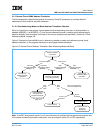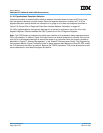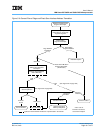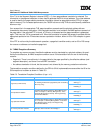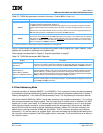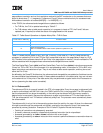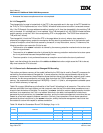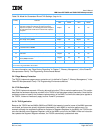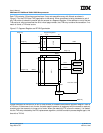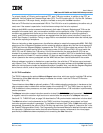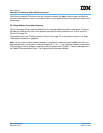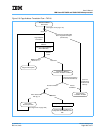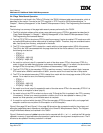
User’s Manual
IBM PowerPC 750GX and 750GL RISC Microprocessor
gx_05.fm.(1.2)
March 27, 2006
Memory Management
Page 197 of 377
page-address translation and not for translations made with the BAT mechanism or for accesses that corre-
spond to direct-store (T = 1) segments. Furthermore, R and C bits are maintained only for accesses made
while address translation is enabled (MSR[IR] = 1 or MSR[DR] = 1).
In the 750GX, the referenced and changed bits are updated as follows.
• For TLB hits, the C bit is updated according to Table 5-7.
• For TLB misses, when a table-search operation is in progress to locate a PTE, the R and C bits are
updated (set, if required) to reflect the status of the page based on this access.
Table 5-7 shows that the status of the C bit in the TLB entry (in the case of a TLB hit) is what causes the
processor to update the C bit in the PTE (the R bit is assumed to be set in the page tables if there is a TLB
hit). Therefore, when software clears the R and C bits in the page tables in memory, it must invalidate the TLB
entries associated with the pages whose referenced and changed bits were cleared.
The Data Cache Block Touch (dcbt) and Data Cache Block Touch for Store (dcbtst) instructions can execute
if there is a TLB or BAT hit or if the processor is in real-addressing mode. In the case of a TLB or BAT miss,
these instructions are treated as no-ops. They do not initiate a table-search operation, and they do not set
either the R or C bits.
As defined by the PowerPC Architecture, the referenced and changed bits are updated as if address transla-
tion were disabled (real-addressing mode). If these update accesses hit in the data cache, they are not seen
on the external bus. If they miss in the data cache, they are performed as typical cache-line-fill accesses on
the bus (assuming the data cache is enabled).
5.4.1.1 Referenced Bit
The referenced (R) bit of a page is located in the PTE in the page table. Every time a page is referenced (with
a read or write access) and the R bit is zero, the 750GX sets the R bit in the page table. The OEA specifies
that the referenced bit can be set immediately, or the setting can be delayed until the memory access is
determined to be successful. Because the reference to a page is what causes a PTE to be loaded into the
TLB, the referenced bit in all TLB entries is effectively always set. The processor never automatically clears
the referenced bit.
The referenced bit is only a hint to the operating system about the activity of a page. At times, the referenced
bit might be set although the access was not logically required by the program or even if the access was
prevented by memory protection. Examples of this in PowerPC systems include the following:
• Fetching of instructions not subsequently executed.
• A memory reference caused by a speculatively executed instruction that is mispredicted.
• Accesses generated by an lswx or stswx instruction with a zero length.
• Accesses generated by an stwcx. instruction when no store is performed because a reservation does not
exist.
Table 5-7. Table-Search Operations to Update History Bits—TLB Hit Case
R and C bits in TLB Entry Processor Action
00 Combination does not occur
01 Combination does not occur
10
Read: No special action
Write: The 750GX initiates a table-search operation to update the C bit.
11 No special action for read or write



